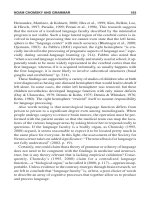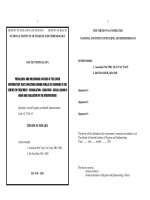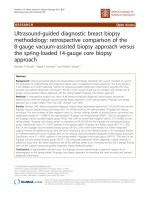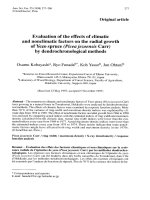Deloitte’s Job Evaluation Approach The 8 Factors
Bạn đang xem bản rút gọn của tài liệu. Xem và tải ngay bản đầy đủ của tài liệu tại đây (211.74 KB, 20 trang )
Human Capital
The 8 Factors
Deloitte’s job evaluation approach
The 8 Factors
Sustaining a culture of continuous learning
2
The 8 Factors
Sustaining a culture of continuous learning
Contents
Page
The talent crisis is real. Are you ready?
4
Rewards should remain your organisation’s priority
6
So how does job evaluation fit into all of this?
7
Going beyond internal equity
10
A brief understanding of job evaluation
11
Can we fairly compare apples to oranges?
12
Deloitte’s 8 Factors of job evaluation
13
Which factors matter most to your organisation?
16
Reward your people and organisation
18
3
The 8 Factors
Sustaining a culture of continuous learning
The talent crisis is real. Are you ready?
Talent today has evolved from a traditionally HR
concern to a key business issue, ranking high
on many CEOs’ and top executives’ priority
lists. Businesses are paying more attention to
talent than ever before, and with good reason:
the imminent retirement of the baby boomer
generation, coupled with an ageing workforce,
mean that organisations already face a brain
drain of skills and experience.
Attracting and retaining the right people has
never been so important. Given the current
talent shortage, it’s vital to understand the new
shape of today’s workforce and design your
talent management strategy accordingly.
So what’s driving today’s talent market?
Shifting demographics. The global working
population looks dramatically different from
30 years ago, as the proportion of women
and racial/ethnic minorities in the workforce
continues to rise.
Values and expectations. The first generation
to have grown up with the internet has begun
to enter the workforce, and they’ve brought
their major values – flexibility, mobility, and
personal development – with them. But those
values aren’t exclusive to Gen-X or Gen-Y; many
baby boomers and veterans want the same
things their adult children do, causing a shift in
workplace expectations as a whole.
4
Changing nature of work. Globalisation and
technology have changed the way people and
organisations communicate, and ultimately
work. The concept of the virtual workplace has
become more and more widespread, resulting
in changes to when, where, and how work gets
done.
Supply and demand. The average age of
employees continues to rise, highlighting the
upcoming baby boomer retirement. Knowledge
retention is also an issue, as businesses face a
decrease in the number of middle managers.
The overall demand for workers is already
beginning to exceed supply.
A proactive approach to these trends will keep
you one step ahead in the war for talent.
Are you ready?
The 8 Factors
Sustaining a culture of continuous learning
In talent management circles, the term Total Rewards includes more
than compensation, benefits and perks. It encompasses all the tangible
and intangible elements of the work experience that affect an employee’s
on-the-job behaviour, including intangibles such as work/life balance,
corporate culture and opportunities for personal development.
Total rewards
•Non-cash incentives
•Recognition programs
•Develop-Deploy-Connect
•Culture/environment
•Communications
•Reward delivery/administration
•Global sourcing
•Intrinsic rewards
•Job enrichment
•Work/life balance
•Career advancement
•Feedback
•Vision and values
Total compensation
•Health / Welfare Benefits •Pension, post-
•Equity
retirement welfare
•Perks
and Supplemental
Executive Retirement
Plans
Total cash
•Base Salary
•Annual Cash Incentive
•Long-term cash incentive
•Annual merit pay
5
The 8 Factors
Sustaining a culture of continuous learning
Rewards should remain your organisation’s
priority
We agree that there exists more than one
solution to talent, and more than one way to
combine them. The trick is finding the right
combination of solutions for your organisation.
Trying to figure out where to invest can be
tricky, as total rewards encompass all elements
of the work experience.
So where do you start?
Whatever combination you eventually settle on,
one element will always be an integral part of it.
In the 2008 Top Five Total Rewards Priorities
Survey, employers agreed that Total Rewards
programme plays a crucial role in their critical
workforce.
Today’s employers are caught between trying to
cut reward costs, while improving the ability of
those rewards to attract, motivate, and retain
employees. At the same time, they face rising
costs of rewards and increased competition for
talent; hence maximising rewards efficiency
takes on added importance. The cost of total
rewards can often exceed 40% of a company’s
revenue, but that 40% means nothing if it’s not
invested wisely. Where are those dollars going to
make the biggest difference?
6
Well, before you can get to where you’re going,
you have to find out where you are.
Establish internal equity within your own
organisation first. Make sure you’re committed
to the concept of equal work, equal pay; there’s
no point in trying to create more value through
your employees if you don’t know their value to
begin with.
Once you establish internal consistency and get
everyone on the same page, then you can tailor
your rewards programme to better meet your
employees’ needs.
The 8 Factors
Sustaining a culture of continuous learning
So how does job evaluation fit into all of this?
Job evaluation (“JE”) determines the relative
value of jobs within an organisation, which
enables you to establish that all-important
internal equity. If you want to put “equal work
equal pay” into practice, you first need to make
sure that it is equal work.
Any JE system worth its salt should strike a
balance between art and science. Of course you
can’t fully eliminate subjectivity, but all methods
should use a consistent, systematic approach.
Remember too that a JE evaluates the content,
roles, and responsibilities of the job – not the
people performing it.
In its simplest form, JE orders jobs by rank.
On the other hand, an analytical JE assigns
scores to jobs, going beyond simple ranking to
quantifying job value.
Effectively, you need the latter to provide a fair,
defensible basis for a rewards structure.
It’s not enough to simply know that one job has
more value to your organisation compared to
another; you need to know how much more
value that job holds, and begin to determine
your rewards philosophy from there.
7
The 8 Factors
Sustaining a culture of continuous learning
Take the test
The need for a JE may be triggered internally or externally, by one or several factors. Here’s a quick
test to see if your organisation would require JE. (Check all that apply.)
Internal Triggers
External Triggers
oEmployee grievances with current rewards
oIncreased competition for critical talent
package
oA need to maximise rewards efficiency
oA need to standardise rewards structure
oOrganisation is entering a new market or
offering new services
oSignificant change in competitors’ rewards
packages
oAn unexpected or unexplained increase
in employee turnover, especially in critical
workforce segments
oAn unexpected or unexplained decrease in
employee productivity
oSignificant introduction of new job or revision
of existing jobs
oA merger, acquisition, or divestiture
oA significant shift in business model or strategy
oOrganisation redesign / transformation
If you checked one or more boxes, then you should conduct JE for your organisation. JE may not
directly alleviate some of these triggers; however, it acts as a stepping stone and foundation for
solutions that will.
8
The 8 Factors
Sustaining a culture of continuous learning
A well-executed job evaluation lays the groundwork for strong HR
solutions such as Job Design, Organisation Design, Salary Structure, Job
Grading, or Career Pathing.
HR Solutions
Job Design
Organisation
Design
Salary
Structure
Job Grading
Career Pathing
Encompassing
the design of
workgroups
and individual
roles,
responsibilities,
accountabilities,
competencies,
and metrics
to enable
deployment
of process,
technology, or
compliancedriven change.
This helps
to align an
individual’s
job with the
organisation’s
objectives.
Comprising
the design of
the hierarchy,
roles and
responsibilities,
competencies,
and metrics of
the functional/
business unit/
process-driven
structures.
This includes
organisation
sizing and
staffing
requirements.
Ensuring
internal and
external equity
of the basic
salary, including
the formulation
of the minimum
and maximum
pay, midpoint
and range
differential, and
overlapping
degree of the
salary structure,
in order to
administer the
orgnisation’s
pay philosophy.
Determining
the clear
delineation
and number of
grades within
the organisation
to form the
basis of
compensation
and benefits
structure, job
levels and
families, and
reporting
hierarchy.
Paving the
career structure
for the
organisation,
encompassing
shared and
specialised
competencies,
capability
development
plan, leadership
development
plan, and
training needs
analysis,
in order to
manage the
continuous
progression of
the employees.
Job Evaluation
“The loftiest edifices need the deepest foundations.”-- George Santayana
9
The 8 Factors
Sustaining a culture of continuous learning
Going beyond internal equity
Beyond establishing internal equity for your
rewards programme, the solid foundation JE
provides also serves as a stepping stone to
many other HR solutions. Furthermore, JE has
additional benefits in and of itself for your
organisation as a whole:
It helps to set and clarify standards. After a
JE, your employees should be clear on their own
roles and responsibilities, as well as their job’s
relationship to other roles in your organisation.
Your HR department should also have a better
understanding of everyone’s roles – along with
your organisation’s structure – that allows them
to tailor job descriptions, recruitment, and
training appropriately.
10
It makes your HR more efficient. After a JE,
you may realise that you have a lot of people
doing essentially the same job, except they
all have different titles. You can potentially
eliminate a lot of redundant job titles and
descriptions, creating a leaner, more efficient
organisation.
It serves as a wake-up call. Is someone’s
paycheck off the charts for the work they do?
Or is someone getting underpaid compared to
another person with similar responsibilities? Or
perhaps when participating in the JE, you found
out that someone is actually working in that
abandoned cubicle (well, the one you thought
was abandoned). By conducting a JE, you can
identify pay anomalies, poor working conditions,
or environmental hazards you may not have
noticed otherwise.
The 8 Factors
Sustaining a culture of continuous learning
A brief understanding of job evaluation
There are two widely recognised approaches to
JE: non-analytical and analytical.
Non-analytical JEs include job ranking and whole
job classification, and involve simply ranking jobs
according to their relative value. This approach
has the advantages of being simple, fast and
relatively inexpensive. However, it does not
consider different compensable factors of a job
(for instance, the physical effort it requires) and
is more subjective, making it difficult to ensure
pay equity compliance.
In contrast, analytical JEs use a number of
compensable factors that are broadly defined,
and assign points to each factor. These include
point factor rating and weighted point factor
comparison. Therefore, analytical JEs provide an
objective, systematic approach to quantifying
job value, ensuring pay equity compliance.
From Deloitte’s point of view, the weighted
point factor comparison method is an effective
mix of both qualitative and quantitative
measures, as it:
• Uses a number of compensable factors that
are broadly defined (a compensable factor is
a job element that is valued by the
organisation and that they are willing to pay
for)
• Assigns points to each factor, where each
factor is typically weighted differently within
the overall framework based on a number of
quantitative and qualitative considerations.
In fact, a weighted point factor comparison can
be applied to more than just jobs; you can even
compare apples to oranges!
11
The 8 Factors
Sustaining a culture of continuous learning
Can we fairly compare apples to oranges?
We sure can.
As an example, we can compare apples and oranges in two main aspects: physical appearance, and
properties when eaten.
These criteria are then further divided into eight specific factors: Texture, Colour, Weight, Size,
Taste, Calories, Water content, and Nutrional value.
Apple
Factors
Texture
(1: Smooth; 7: Rough)
Colour
(1: Light; 9: Dark)
Weight
(1: Light; 10: Heavy)
Size
(1: Small; 7: Large)
Taste
(1: Sour; 8: Sweet)
Calories
(1: Low; 8: High)
Water content
(1: Low; 8: High)
Nutritional value
(1: Low; 9: High)
Appearance
Effect
12
Orange
The 8 Factors
Sustaining a culture of continuous learning
Deloitte’s 8 Factors of job evaluation
Similarly, every job has four standard criteria recognised in all pay equity legislation. When making
a pay equity claim, the claimant has to be able to show that his or her job holds equal value to
another one, based on an analysis of these four criteria: Skill, Effort, Responsibility and Working
Conditions.
Accountant
Factors
Secretary
Knowledge
Minimum level of job knowledge (skills, expertise,
know-how and ability) required to do the job.
Interpersonal Skills
Job requirements for using interpersonal
communication skills. Please consider all forms of
interpersonal contact.
Physical, Visual and Auditory Demands
Demands placed upon employee that are not
creative or mental job requirements. E.g. manual
dexterity.
Complexity
Amount and difficulty of analysis, problem solving
and reasoning required to perform job related duties.
Accountability and Decision Making
Level of accountability and decision making
associated with position. E.g. level of work review or
supervision received.
Impact
Measures impact of the work as a result of activities
performed.
Development and Leadership of Others
Direct accountability for supervision of others.
Environmental Working Conditions
Likelihood, frequency, and severity of exposure to
undesirable features in the work environment.
13
The 8 Factors
Sustaining a culture of continuous learning
Try it!
Factors
Knowledge
(1: Basic; 8: Extensive)
Interpersonal Skills
(1: Very limited; 9: Very high)
Physical, Visual and Auditory Demands
(1: Very minor & low frequency; 9: Very high & high
frequency)
Complexity
(1: Very limited; 9: Extremely high/Very substantial)
Accountability and Decision Making
(1: Very limited; 9: Extreme)
Impact
(1: Very limited; 9: Extreme)
Development and Leadership of Others
(1: Guidance and advice; 9: Multiple and large
group responsibility)
Environmental Working Conditions
(1: Does not apply; 7: Extremely adverse/severe &
high frequency)
Skill
14
Effort
Responsibility
Working conditions
The 8 Factors
Sustaining a culture of continuous learning
Deloitte’s 8 Factors are developed based on these criteria, providing a
gender-neutral, pay equity compliant tool that is equally applicable to
all positions within an organisation.
Interpersonal
Skill (IS)
Knowledge
Accountability
and Decision
Making (ADM)
Development
and
Leadership of
Others (DLO)
Effort
Complexity
The 8 Factors
Impact
Skill
Physical,
Visual and
Auditory
Demands
(PVA)
Responsibility
Environmental
Working
Conditions
(EWC)
Working conditions
15
The 8 Factors
Sustaining a culture of continuous learning
Which factors matter most to your
organisation?
The opposite page shows a JE for an organisation that places equal weight on all eight factors.
However, in practice, every organisation has different needs and priorities.
The 8 Factors are carefully tailored and weighted to give you a more accurate picture of a job’s
value – specific to your organisation.
Organisation I
If this organisation considers
knowledge and complexity
especially crucial to their
employee productivity, their 8
Factors could look like this:
IS
Knowledge
PVA
Complexity
The 8 Factors
ADM
EWC
Impact
DLO
Organisation II
If this organisation values
responsibility most highly,
their 8 Factors could look
like this:
Knowledge
ADM
IS
PVA
Complexity
The 8 Factors
EWC
Impact
DLO
Skill
16
Effort
Responsibility
Working conditions
The 8 Factors
Sustaining a culture of continuous learning
Investment in JE
• Time
• Money
• Effort
Organisation
Job evaluation
Benefits for employees
• More effective total
rewards programme
• Greater trust and
understanding of
organisation
Direct ROI
More effective
HR processes
Employees
Indirect ROI
(passed on through employee benefits).
Increased employee satisfaction and productivity
17
The 8 Factors
Sustaining a culture of continuous learning
Reward your people and organisation
JE gives you a foundation for far more than just
total rewards. It strengthens your HR function as
a whole, directly benefitting the organisation.
However, JE’s direct ROI is just one part of it; it
brings just as much value to the table through
your employees. A JE analysis provides the facts
you need to establish internal equity. From
there, you can be sure of aligning your rewards
programme with pay equity – so everyone gets
rewarded appropriately for the work they do.
That increased satisfaction and loyalty gets
passed on to your organisation, in the form of
greater productivity and retention.
Not to mention the very act of conducting JE
builds trust between employer and employee.
Doing JE as a joint exercise fosters better
understanding of your rewards programme, and
that in turn gives it more credibility.
18
JE by itself won’t automatically solve your talent
problems, increase reward efficiency or maintain
internal equity. But it will give you a great
springboard from which to do so. A stronger HR
function, reward efficiency, and higher employee
retention are just a step away.
Contact us
Andrew Lee, Director
Human Capital Services Group
Deloitte Consulting Malaysia
Tel: +603 7723 6500
Fax: +603 7726 3986
Email:
Deloitte
Level 19, Uptown 1,
1 Jalan SS21/58, Damansara Uptown
47400 Petaling Jaya, Selangor
Malaysia
Deloitte provides audit, tax, consulting, and financial advisory services to public and
private clients spanning multiple industries. With a globally connected network of
member firms in 140 countries, Deloitte brings world-class capabilities and deep
local expertise to help clients succeed wherever they operate. Deloitte’s 165,000
professionals are committed to becoming the standard of excellence.
Deloitte’s professionals are unified by a collaborative culture that fosters integrity,
outstanding value to markets and clients, commitment to each other, and strength
from cultural diversity. They enjoy an environment of continuous learning,
challenging experiences, and enriching career opportunities. Deloitte’s professionals
are dedicated to strengthening corporate responsibility, building public trust, and
making a positive impact in their communities.
Deloitte refers to one or more of Deloitte Touche Tohmatsu, a Swiss Verein, and
its network of member firms, each of which is a legally separate and independent
entity. Please see www.deloitte.com/my/about for a detailed description of the legal
structure of Deloitte Touche Tohmatsu and its member firms.
About Deloitte Malaysia
In Malaysia, Deloitte KassimChan is the member firm of Deloitte Touche Tohmatsu,
and services are provided by Deloitte KassimChan and its affiliates.
Deloitte KassimChan is part of Deloitte Southeast Asia—a cluster of member firms
operating in Brunei, Guam, Indonesia, Malaysia, Philippines, Singapore, Thailand
and Vietnam—which was established to deliver measurable value to the particular
demands of increasingly intra-regional and fast growing companies and enterprises.
With a team of over 200 partners and 4,000 professionals located in 20 offices,
Deloitte Southeast Asia specialists combine their technical expertise and deep
industry knowledge to deliver consistent high quality services to companies in the
region.
All services are provided through the individual member firms, their subsidiaries and
affiliates which are separate and independent legal entities.
Disclaimer
This publication contains general information only, and none of Deloitte Touche
Tohmatsu, its member firms, or its and their affiliates are, by means of this publication, rendering accounting, business, financial, investment, legal, tax, or other professional advice or services. This publication is not a substitute for such professional
advice or services, nor should it be used as a basis for any decision or action that
may affect your finances or your business. Before making any decision or taking any
action that may affect your finances or your business, you should consult a qualified
professional adviser.
None of Deloitte Touche Tohmatsu, its member firms, or its and their respective
affiliates shall be responsible for any loss whatsoever sustained by any person who
relies on this publication.
© 2008 Deloitte Consulting Malaysia Sdn Bhd









